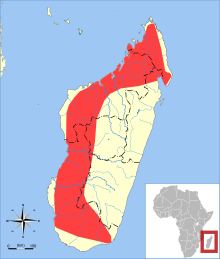Triaenops menamena
| Triaenops menamena | |
|---|---|

| |
| Skull of Triaenops menamena | |
| Scientific classification | |
| Domain: | Eukaryota |
| Kingdom: | Animalia |
| Phylum: | Chordata |
| Class: | Mammalia |
| Order: | Chiroptera |
| Family: | Rhinonycteridae |
| Genus: | Triaenops |
| Species: | T. menamena
|
| Binomial name | |
| Triaenops menamena Goodman and Ranivo, 2009
| |

| |
| Distribution of Triaenops menamena (in green) and other species of Triaenops | |

| |
| Triaenops menamena range | |
Triaenops menamena is a
With a forearm length of 50 to 56 mm (2.0 to 2.2 in) in males and 46 to 53 mm (1.8 to 2.1 in) in females, this is a medium-sized bat. Its fur color is variable, ranging from reddish brown to gray, but it is generally darker than the species in the closely related genus Paratriaenops which also occur on Madagascar. The skull contains a pronounced swelling around the nose and the second upper premolar is displaced outside the toothrow. The maximum frequency of the echolocation call averages 94.2 kHz and the species can easily be recognized on the basis of its call.
Taxonomy
In 1881,
Triaenops menamena is currently one of four living species in the genus Triaenops; a 2009 revision by Petr Benda and Peter Vallo split off the African
Description
| Sex | n[Note 1] | Total length | Tail | Hindfoot | Ear | Forearm | Mass |
|---|---|---|---|---|---|---|---|
| Male | 28[Note 2] | 90–104 | 27–38 | 6–9 | 14–17 | 50–56 | 8.2–15.5 |
| Female | 67 | 86–98 | 28–39 | 6–9 | 12–17 | 46–53 | 6.6–11.5 |
| Measurements are in millimeters (except weight in grams) and in the form "minimum–maximum". | |||||||
Triaenops menamena is a medium-sized species with variable fur coloration, ranging from reddish brown to gray. It is larger and darker than Paratriaenops auritus and P. furcula.
The skull is similar to that of Madagascan Paratriaenops, but the
The upper
The species can easily be identified from recordings of its echolocation call.[24] The call consists of a component with constant frequency followed by a short one with changing frequency. The call takes 6.5 to 13.5 ms, averaging 10.1 ms, and the period between two calls is 22.7 to 86.3 ms, averaging 42.7 ms. The maximum frequency averages 94.2 kHz, the minimum frequency averages 82.0 kHz, and the call emits the most energy at a frequency of 93.2 kHz.[25]
Distribution and ecology
Triaenops menamena mainly occurs in the dry regions of western Madagascar, but has also been recorded in humid areas in the far southeast and northeast,
Conservation status
Under Triaenops rufus, the
Footnotes
References
- ^ a b c d e Andriafidison et al., 2008
- ^ Milne-Edwards, 1881, p. 1035
- ^ Goodman and Ranivo, 2009, p. 47; Benda and Vallo, 2009, table 1
- ^ Benda and Vallo, 2009, p. 7
- ^ Ranivo and Goodman, 2007, pp. 963, 975
- ^ Goodman and Ranivo, 2009, p. 52
- ^ Goodman and Ranivo, 2009, pp. 52–53
- ^ a b Goodman and Ranivo, 2009, p. 54
- ^ Benda and Vallo, 2009, p. 34
- ^ a b c Samonds, 2007, p. 46
- ^ Russell et al., 2007, p. 839; 2008, p. 995
- ^ Benda and Vallo, 2009, pp. 27–28
- ^ a b Ranivo and Goodman, 2006, p. 982
- ^ a b c Peterson et al., 1995, p. 82
- ^ a b Benda and Vallo, 2010, p. 29
- ^ a b Yoshiyuki, 1995, p. 119
- ^ Goodman and Ranivo, 2008, p. 686
- ^ a b Yoshiyuki, 1995, p. 120
- ^ Garbutt, 2007, p. 71
- ^ a b Ranivo and Goodman, 2006, p. 971
- ^ a b Ranivo and Goodman, 2006, p. 972
- ^ Benda and Vallo, 2010, pp. 29–30
- ^ a b c Ranivo and Goodman, 2006, p. 974
- ^ Kofoky et al., 2007, p. 1042
- ^ Kofoky et al., 2009, table 1, p. 380, fig. 4a
- ^ Kofoky et al., 2007, p. 1049
- ^ Racey et al., 2010, p. 392
- ^ Olsson et al., 2006, p. 402; Kofoky et al., 2007, p. 1047
- ^ Russell et al., 2008, p. 998
- ^ Rakotoarivelo et al., 2007, table 2
- ^ Rakotoarivelo et al., 2007, p. 964
- ^ Goodman, 2006, pp. 225–226
Literature cited
- Andriafidison, D., Cardiff, S.G., Goodman, S.M., Hutson, A.M., Jenkins, R.K.B., Kofoky, A.F., Racey, P.A., Ranivo, J., Ratrimomanarivo, F.H. and Razafimanahaka, H.J. 2008. Triaenops rufus. In IUCN. IUCN Red List of Threatened Species. Version 2009.2. <www.iucnredlist.org>. Downloaded on May 29, 2010.
- Benda, P. and Vallo, P. 2009. Taxonomic revision of the genus Triaenops (Chiroptera: Hipposideridae) with description of a new species from southern Arabia and definitions of a new genus and tribe. Folia Zoologica 58(Monograph 1):1–45.
- Garbutt, N. 2007. Mammals of Madagascar: A Complete Guide. A & C Black, 304 pp. ISBN 978-0-7136-7043-1
- Goodman, S.M. 2006. Hunting of Microchiroptera in south-western Madagascar (subscription required). Oryx 40(2):225–228 .
- Goodman S.M. and Ranivo, J. 2008. A new species of Triaenops (Mammalia, Chiroptera, Hipposideridae) from Aldabra Atoll, Picard Island (Seychelles). Zoosystema 30(3):681–693.
- Goodman, S.M. and Ranivo, J. 2009. The geographical origin of the type specimens of Triaenops rufus and T. humbloti (Chiroptera: Hipposideridae) reputed to be from Madagascar and the description of a replacement species name] (subscription required). Mammalia 73:47–55 .
- Kofoky, A.F., Andriafidison, D., Ratrimomanarivo, F.H., Razafimanahaka, H.J., Rakotondravony, D., Racey, P.A. and Jenkins, R.K.B. 2007. Habitat use, roost selection and conservation of bats in Tsingy de Bemaraha National Park, Madagascar Archived 2011-07-27 at the ISBN 978-1-4020-6319-0.
- Kofoky, A.F., Randrianandrianina, F., Russ, J., Raharinantenaina, I., Cardiff, S.G., Jenkins, R.K.B. and Racey, P.A. 2009. Forest bats of Madagascar: results of acoustic surveys (subscription required). Acta Chiropterologica 11(2):375–392 .
- Milne-Edwards, A. 1881. Observations sur quelques animaux de Madagascar. Comptes rendus hebdomadaires des séances de l'Académie des sciences, Paris 91:1034–1038 (in French).
- Olsson, A., Emmett, D., Henson, D. and Fanning, E. 2006. Activity patterns and abundance of microchiropteran bats at a cave roost in southwest Madagascar (subscription required). African Journal of Ecology 44:401–403 .
- Peterson, R.L., Eger, J.L. and Mitchell, L. 1995. Chiroptères. Faune de Madagascar 84:1–204 (in French).
- Racey, P.A., Goodman, S.M. and Jenkins, R.K.B. 2010. The ecology and conservation of Malagasy bats. pp. 369–404 in Fleming, T.H. and Racey, P.A. (eds.). Island Bats: Evolution, Ecology, and Conservation. University of Chicago Press, 549 pp. ISBN 978-0-226-25330-5
- Rakotoarivelo, A.A., Ranaivoson, N., Ramilijaona, O.R., Kofoky, A.F., Racey, P.A. and Jenkins, R.K.B. 2007. Seasonal food habits of five sympatric forest microchiropterans in western Madagascar (subscription required). Journal of Mammalogy 88(4):959–966 .
- Ranivo, J. and Goodman S.M. 2006. Révision taxinomique des Triaenops malgaches (Mammalia, Chiroptera, Hipposideridae). Zoosystema 28(4):963–985 (in French).
- Russell, A.L., Ranivo, J., Palkovacs, E.P., Goodman, S.M. and Yoder, A.D. 2007. Working at the interface of phylogenetics and population genetics: a biogeographical analysis of Triaenops spp. (Chiroptera: Hipposideridae). Molecular Ecology 16:839–851PMID 17284215.
- Russell, A.L., Goodman, S.M. and Cox, M.P. 2008. Coalescent analyses support multiple mainland-to-island dispersals in the evolution of Malagasy Triaenops bats (Chiroptera: Hipposideridae) (subscription required). Journal of Biogeography 35:995–1003 .
- Samonds, K.E. 2007. Late Pleistocene bat fossils from Anjohibe Cave, northwestern Madagascar. Acta Chiropterologica 9(1):39–65 2.0.CO;2].
- Yoshiyuki, M. 1995. Two rare species of the bats, Triaenops rufus and Mormopterus jugularis (Mammalia, Chiroptera) from Madagascar. Bulletin of the National Science Museum, Tokyo (A)21(2):119–126.

